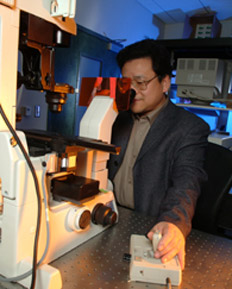Research
September 21, 2011
Transformative NIH grant targets lung cancer recurrence

Shuming Nie
If a tumor is more visible and easier to distinguish from surrounding tissues, surgeons will be more likely to be able to remove it completely. That's the rationale behind a new $7 million, five-year "transformative" grant from the National Institutes of Health to a team of researchers from Emory, Georgia Tech and the University of Pennsylvania's Perelman School of Medicine.
The grant is part of the NIH Director's Awards Program funded by the NIH Common Fund.
Shuming Nie and his colleagues at the Emory-Georgia Tech Nanotechnology Center for Personalized and Predictive Oncology have been developing fluorescent nanoparticle probes that home in on cancer cells. The grant will support the team's continuing work on the nanoparticles and instruments that visualize them for cancer detection during surgery.
The project team includes May Wang, director of biocomputing and bioinformatics at the Nanotechnology Center and Sunil Singhal, director of the Thoracic Surgery Research Laboratory at the Perelman School of Medicine. Nie is a professor and Wang is associate professor in the Wallace H. Coulter Department of Biomedical Engineering at Georgia Tech and Emory University.
"At present, a significant group of patients who undergo surgery leave the operating room without a complete resection due to missed lesions," Nie says. "Our main goals are to help surgeons distinguish tumor margins, identify diseased lymph nodes and micrometastases, and to determine if the tumor has been completely removed. Having these capabilities can be expected to make a major impact in reducing recurrence rates of lung cancer after surgery."
The grant includes plans for tests of the nanoparticles and cancer detection instruments on dogs with naturally occurring lung tumors and a first-in-human clinical trial for patients with lung cancer at the University of Pennsylvania.
Nie and his colleagues have developed a hand-held device called a SpectroPen that can detect the two types of agents for detecting cancer: a fluorescent dye and gold particles.
The award was one of 17 granted this year through the NIH Director's Transformative Research Projects Program (T-R01), which was created to nurture innovative ideas that have the potential to advance fields and speed the translation of research into improved health for the American public.
Grant for tissue regeneration
Another T-RO1 grant, for $2 million over five years, was awarded to Todd McDevitt, director of the Stem Cell Engineering Center at Georgia Tech and an associate professor in the Wallace H. Coulter Department of Biomedical Engineering at Georgia Tech and Emory, along with Coulter associate professor Johnna Temenoff, and Woodruff School of Mechanical Engineering professor Robert Guldberg. The grant will support the development of tissue regeneration therapeutics for traumatic injuries and degenerative diseases.
"The NIH Director's Award programs reinvigorate the biomedical work force by providing unique opportunities to conduct research that is neither incremental nor conventional," says James M. Anderson, director of the Division of Program Coordination, Planning and Strategic Initiatives, at NIH. "The awards are intended to catalyze giant leaps forward for any area of biomedical research, allowing investigators to go in entirely new directions."
